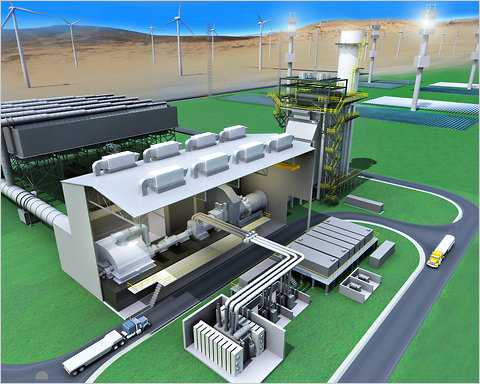By MATTHEW L. WALD
The design for a hybrid electric plant that makes steam from natural gas and from solar power, supplemented by wind machines.General ElectricA hybrid electric plant designed by General Electric. Mirrors focus sunlight on power towers, top right, that make steam that is injected through pipes into a turbine,center, to make electricity. Wind turbines, rear, make electricity to either help run the plant or to feed the grid.

Green: Business
How can the electric system take intermittent energy sources like wind and sun and integrate them with conventional fuels for electricity, like natural gas?
General Electric and a small California company called eSolar announced a new strategy on Tuesday: use the solar power to make steam that will supplement the steam from the natural gas. And tack on some wind machines nearby, in an arrangement that lets the natural gas compensate for variations in the wind and sun.
The technology turns a natural gas plant and a solar plant into conjoined twins; wind is more like a half-sibling.
The two companies said they would break ground this year on a hybrid electric plant in Karaman, Turkey, to be owned by a Turkish project developer called MetCap Energy Investments. Part of it will look like a conventional combined-cycle gas plant, in which the natural gas is burned in a jet engine that drives a generator, and the exhaust gases are used to make steam to turn a steam turbine that also drives a generator.
But standing nearby is a 250-foot tower surrounded by about 25,000 mirrors, each about the size of a big flat-screen television. Computers keep the mirrors focused on the tower, and inside the tower, water is boiled into steam. The steam flows into the turbine along with steam from the natural gas plant.
In broad outline, using the sun to boil water into steam and supplementing that with natural gas is not new. But most such projects use parabolic troughs with black pipes running down the center. The tower design allows steam to be heated to temperatures 200 degrees higher than the troughs, which means that the system will produce far more electricity per acre.
The design is rather modest on the renewables side; the plan is for 450 megawatts of natural gas, 50 megawatts of solar power and 22 megawatts of wind power. But Turkey grants a subsidy equal to 10 euro cents a kilowatt-hour for renewable power, said Paul Browning, president and chief executive of the thermal products division of GE Energy.
“There are some savings from the control system, the switch yard, some of the interconnections,”’ Mr. Browning added. G.E. is boasting that the plant will be 69 percent efficient, a phenomenally high number. Most natural gas plants have an efficiency ranging from 30 to 50 percent.
GE calculates the figure by counting the sun and wind at zero, as a kind of hamburger helper for the natural gas. The calculation ignores the wind and sun that does not get converted to electricity, but on the other hand, the wind and sun are inexhaustible.
The design is based on a new model of G.E. natural gas plant called FlexEfficiency that is able to vary its output rapidly to make it a good dance partner for variable sources like wind and sun.
Mr. Browning said a customer that was considering supplementing natural gas with solar power would have to weigh the cost of gas, the cost of capital and the available incentives. “Gas in the U.S. is very cheap right now, and the renewable incentives in the U.S. are — let’s call them inconsistent and difficult to project into future,” he said. The price of natural gas in Turkey is more than double the price in the United Sates, he said.
The Turkish plant will be in commercial operation by 2015, he said. Future plants could have a higher proportion of solar energy, depending on market conditions, he said.
The California company eSolar operates two power towers on the edge of the Mojave Desert. Last year it received an $11 million grant from the Energy Department to work on the design of a system that would heat molten salt rather than water. The salt stores heat that can be turned into electricity during periods of clouds or darkness, said John Van Scoter, the company’s chief executive and president.
At the Turkish plant, there is no need for storage; the solar part will run when there is sunshine, and be replaced by gas when there is no sun.
via A Hybrid Power Plant Takes Shape in Turkey – NYTimes.com.


